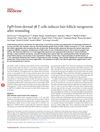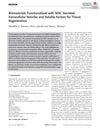Minimizing Skin Scarring Through Biomaterial Design
January 2017
in “
Journal of Functional Biomaterials
”
TLDR Biomaterials can help reduce skin scarring and improve wound healing.
The review discussed the challenges and advancements in wound healing, focusing on the economic and physical burdens of dysfunctional healing. It highlighted the limitations of previous approaches and emphasized the potential of biomaterials that mimic the three-dimensional microenvironment of normal tissue to improve healing. The study explored the role of inflammatory cytokines and macrophages in wound healing, noting the importance of CXCL12 in cell recruitment. Various biomaterials, such as collagen, fibrin, hyaluronic acid, and chitosan, were evaluated for their potential to minimize scarring and enhance healing. Emerging therapies included synthetic polymers and stem cell-based treatments, with a focus on mimicking fetal scarless healing. The review suggested that future products should aim for tissue regeneration without compromising healing speed, ultimately improving outcomes for patients.










